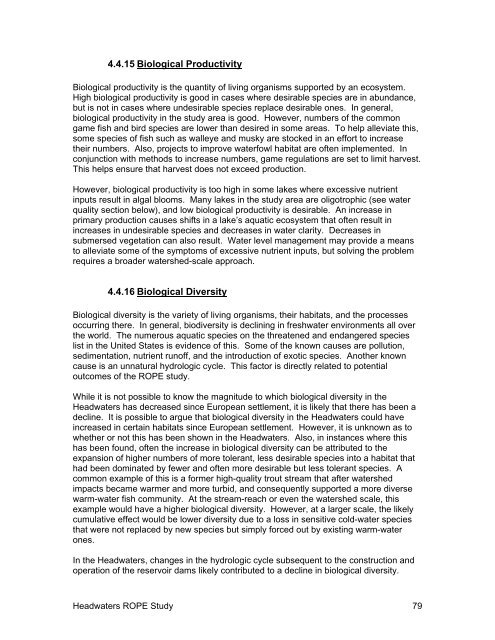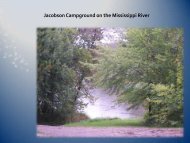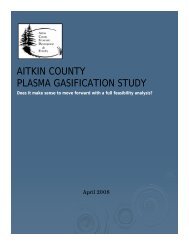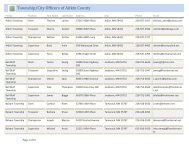Chapter 4: Affected Environment - Aitkin County Government
Chapter 4: Affected Environment - Aitkin County Government
Chapter 4: Affected Environment - Aitkin County Government
- No tags were found...
You also want an ePaper? Increase the reach of your titles
YUMPU automatically turns print PDFs into web optimized ePapers that Google loves.
4.4.15 Biological ProductivityBiological productivity is the quantity of living organisms supported by an ecosystem.High biological productivity is good in cases where desirable species are in abundance,but is not in cases where undesirable species replace desirable ones. In general,biological productivity in the study area is good. However, numbers of the commongame fish and bird species are lower than desired in some areas. To help alleviate this,some species of fish such as walleye and musky are stocked in an effort to increasetheir numbers. Also, projects to improve waterfowl habitat are often implemented. Inconjunction with methods to increase numbers, game regulations are set to limit harvest.This helps ensure that harvest does not exceed production.However, biological productivity is too high in some lakes where excessive nutrientinputs result in algal blooms. Many lakes in the study area are oligotrophic (see waterquality section below), and low biological productivity is desirable. An increase inprimary production causes shifts in a lake’s aquatic ecosystem that often result inincreases in undesirable species and decreases in water clarity. Decreases insubmersed vegetation can also result. Water level management may provide a meansto alleviate some of the symptoms of excessive nutrient inputs, but solving the problemrequires a broader watershed-scale approach.4.4.16 Biological DiversityBiological diversity is the variety of living organisms, their habitats, and the processesoccurring there. In general, biodiversity is declining in freshwater environments all overthe world. The numerous aquatic species on the threatened and endangered specieslist in the United States is evidence of this. Some of the known causes are pollution,sedimentation, nutrient runoff, and the introduction of exotic species. Another knowncause is an unnatural hydrologic cycle. This factor is directly related to potentialoutcomes of the ROPE study.While it is not possible to know the magnitude to which biological diversity in theHeadwaters has decreased since European settlement, it is likely that there has been adecline. It is possible to argue that biological diversity in the Headwaters could haveincreased in certain habitats since European settlement. However, it is unknown as towhether or not this has been shown in the Headwaters. Also, in instances where thishas been found, often the increase in biological diversity can be attributed to theexpansion of higher numbers of more tolerant, less desirable species into a habitat thathad been dominated by fewer and often more desirable but less tolerant species. Acommon example of this is a former high-quality trout stream that after watershedimpacts became warmer and more turbid, and consequently supported a more diversewarm-water fish community. At the stream-reach or even the watershed scale, thisexample would have a higher biological diversity. However, at a larger scale, the likelycumulative effect would be lower diversity due to a loss in sensitive cold-water speciesthat were not replaced by new species but simply forced out by existing warm-waterones.In the Headwaters, changes in the hydrologic cycle subsequent to the construction andoperation of the reservoir dams likely contributed to a decline in biological diversity.Headwaters ROPE Study 79








